kubeadm部署单Master节点kubernetes集群 1.21¶
一、kubernetes 1.21发布¶
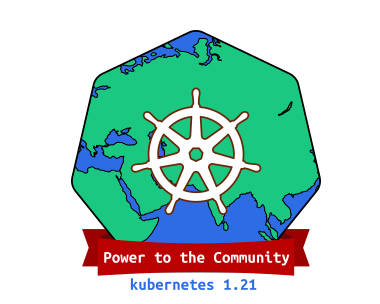
1.1 介绍¶
2021年04月,Kubernetes 1.21正式与大家见面,这是我们 2021 年的第一个版本!这个版本包含 51 个增强功能:13 个增强功能升级为稳定版,16 个增强功能升级为 beta 版,20 个增强功能进入 alpha 版,还有 2 个功能已经弃用。
1.2 主要变化¶
- CronJobs 毕业到稳定!
自 Kubernetes 1.8 以来,CronJobs一直是一个测试版功能!在 1.21 中,我们终于看到这个广泛使用的 API 毕业到稳定。
CronJobs 用于执行定期计划的操作,如备份、报告生成等。每个任务都应该被配置为无限期地重复出现(例如:一天/一周/一个月);你可以在该间隔内定义作业应该启动的时间点。
- 不可变的 Secrets 和 ConfigMaps
Immutable Secrets和ConfigMaps为这些资源类型添加了一个新字段,如果设置了该字段,将拒绝对这些对象的更改。默认情况下,Secrets 和 ConfigMaps 是可变的,这对能够使用更改的 pod 是有益的。如果将错误的配置推送给使用它们的 pod,可变的 Secrets 和 ConfigMaps 也会导致问题。
通过将 Secrets 和 ConfigMaps 标记为不可变的,可以确保应用程序配置不会改变。如果你希望进行更改,则需要创建一个新的、唯一命名的 Secret 或 ConfigMap,并部署一个新的 pod 来消耗该资源。不可变资源也有伸缩性优势,因为控制器不需要轮询 API 服务器来观察变化。
这个特性在 Kubernetes 1.21 中已经毕业到稳定。
- IPv4/IPv6 双栈支持
IP 地址是一种可消耗的资源,集群操作人员和管理员需要确保它不会耗尽。特别是,公共 IPv4 地址现在非常稀少。双栈支持使原生 IPv6 路由到 pod 和服务,同时仍然允许你的集群在需要的地方使用 IPv4。双堆栈集群网络还改善了工作负载的可能伸缩限制。
Kubernetes 的双栈支持意味着 pod、服务和节点可以获得 IPv4 地址和 IPv6 地址。在 Kubernetes 1.21 中,双栈网络已经从 alpha 升级到 beta,并且已经默认启用了。
- 优雅的节点关闭
在这个版本中,优雅的节点关闭也升级到测试版(现在将提供给更大的用户群)!这是一个非常有益的特性,它允许 kubelet 知道节点关闭,并优雅地终止调度到该节点的 pod。
目前,当节点关闭时,pod 不会遵循预期的终止生命周期,也不会正常关闭。这可能会在许多不同的工作负载下带来问题。接下来,kubelet 将能够通过 systemd 检测到即将发生的系统关闭,然后通知正在运行的 pod,以便它们能够尽可能优雅地终止。
- PersistentVolume 健康监测器
持久卷(Persistent Volumes,PV)通常用于应用程序中获取本地的、基于文件的存储。它们可以以许多不同的方式使用,并帮助用户迁移应用程序,而不需要重新编写存储后端。
Kubernetes 1.21 有一个新的 alpha 特性,允许对 PV 进行监视,以了解卷的运行状况,并在卷变得不健康时相应地进行标记。工作负载将能够对运行状况状态作出反应,以保护数据不被从不健康的卷上写入或读取。
- 减少 Kubernetes 的构建维护
以前,Kubernetes 维护了多个构建系统。这常常成为新贡献者和当前贡献者的摩擦和复杂性的来源。
在上一个发布周期中,为了简化构建过程和标准化原生的 Golang 构建工具,我们投入了大量的工作。这应该赋予更广泛的社区维护能力,并降低新贡献者进入的门槛。
1.3 重大变化¶
- 弃用 PodSecurityPolicy
在 Kubernetes 1.21 中,PodSecurityPolicy 已被弃用。与 Kubernetes 所有已弃用的特性一样,PodSecurityPolicy 将在更多版本中继续可用并提供完整的功能。先前处于测试阶段的 PodSecurityPolicy 计划在 Kubernetes 1.25 中删除。
接下来是什么?我们正在开发一种新的内置机制来帮助限制 Pod 权限,暂定名为“PSP 替换策略”。我们的计划是让这个新机制覆盖关键的 PodSecurityPolicy 用例,并极大地改善使用体验和可维护性。
- 弃用 TopologyKeys
服务字段 topologyKeys 现在已弃用;所有使用该字段的组件特性以前都是 alpha 特性,现在也已弃用。我们用一种实现感知拓扑路由的方法替换了 topologyKeys,这种方法称为感知拓扑提示。支持拓扑的提示是 Kubernetes 1.21 中的一个 alpha 特性。你可以在拓扑感知提示中阅读关于替换特性的更多细节;相关的KEP解释了我们替换的背景。
二、kubernetes 1.21.0 部署工具介绍¶
What is Kubeadm ?¶
Kubeadm is a tool built to provide best-practice "fast paths" for creating Kubernetes clusters. It performs the actions necessary to get a minimum viable, secure cluster up and running in a user friendly way. Kubeadm's scope is limited to the local node filesystem and the Kubernetes API, and it is intended to be a composable building block of higher level tools.
Kubeadm是为创建Kubernetes集群提供最佳实践并能够“快速路径”构建kubernetes集群的工具。它能够帮助我们执行必要的操作,以获得最小可行的、安全的集群,并以用户友好的方式运行。
Common Kubeadm cmdlets¶
- kubeadm init to bootstrap the initial Kubernetes control-plane node.
初始化 - kubeadm join to bootstrap a Kubernetes worker node or an additional control plane node, and join it to the cluster.
添加工作节点到kubernetes集群 - kubeadm upgrade to upgrade a Kubernetes cluster to a newer version.
更新kubernetes版本 - kubeadm reset to revert any changes made to this host by kubeadm init or kubeadm join.
重置kubernetes集群
三、kubernetes 1.21.0 部署环境准备¶
3.1 主机操作系统说明¶
| 序号 | 操作系统及版本 | 备注 |
|---|---|---|
| 1 | CentOS7u9 |
3.2 主机硬件配置说明¶
| 需求 | CPU | 内存 | 硬盘 | 角色 | 主机名 |
|---|---|---|---|---|---|
| 值 | 4C | 8G | 100GB | master | master01 |
| 值 | 4C | 8G | 100GB | worker(node) | worker01 |
| 值 | 4C | 8G | 100GB | worker(node) | worker02 |
3.3 主机配置¶
3.3.1 主机名配置¶
由于本次使用3台主机完成kubernetes集群部署,其中1台为master节点,名称为master01;其中2台为worker节点,名称分别为:worker01及worker02
master节点,名称为master1
# hostnamectl set-hostname master01
worker1节点,名称为worker1
# hostnamectl set-hostname worker01
worker2节点,名称为worker2
# hostnamectl set-hostname worker02
3.3.2 主机IP地址配置¶
master节点IP地址为:192.168.10.11/24
# vim /etc/sysconfig/network-scripts/ifcfg-ens33
TYPE="Ethernet"
PROXY_METHOD="none"
BROWSER_ONLY="no"
BOOTPROTO="none"
DEFROUTE="yes"
IPV4_FAILURE_FATAL="no"
IPV6INIT="yes"
IPV6_AUTOCONF="yes"
IPV6_DEFROUTE="yes"
IPV6_FAILURE_FATAL="no"
IPV6_ADDR_GEN_MODE="stable-privacy"
NAME="ens33"
DEVICE="ens33"
ONBOOT="yes"
IPADDR="192.168.10.11"
PREFIX="24"
GATEWAY="192.168.10.2"
DNS1="119.29.29.29"
worker1节点IP地址为:192.168.10.12/24
# vim /etc/sysconfig/network-scripts/ifcfg-ens33
TYPE="Ethernet"
PROXY_METHOD="none"
BROWSER_ONLY="no"
BOOTPROTO="none"
DEFROUTE="yes"
IPV4_FAILURE_FATAL="no"
IPV6INIT="yes"
IPV6_AUTOCONF="yes"
IPV6_DEFROUTE="yes"
IPV6_FAILURE_FATAL="no"
IPV6_ADDR_GEN_MODE="stable-privacy"
NAME="ens33"
DEVICE="ens33"
ONBOOT="yes"
IPADDR="192.168.10.12"
PREFIX="24"
GATEWAY="192.168.10.2"
DNS1="119.29.29.29"
worker2节点IP地址为:192.168.10.13/24
# vim /etc/sysconfig/network-scripts/ifcfg-ens33
TYPE="Ethernet"
PROXY_METHOD="none"
BROWSER_ONLY="no"
BOOTPROTO="none"
DEFROUTE="yes"
IPV4_FAILURE_FATAL="no"
IPV6INIT="yes"
IPV6_AUTOCONF="yes"
IPV6_DEFROUTE="yes"
IPV6_FAILURE_FATAL="no"
IPV6_ADDR_GEN_MODE="stable-privacy"
NAME="ens33"
DEVICE="ens33"
ONBOOT="yes"
IPADDR="192.168.10.13"
PREFIX="24"
GATEWAY="192.168.10.2"
DNS1="119.29.29.29"
3.3.3 主机名与IP地址解析¶
所有集群主机均需要进行配置。
# cat /etc/hosts
127.0.0.1 localhost localhost.localdomain localhost4 localhost4.localdomain4
::1 localhost localhost.localdomain localhost6 localhost6.localdomain6
192.168.10.11 master01
192.168.10.12 worker01
192.168.10.13 worker02
3.3.4 防火墙配置¶
所有主机均需要操作。
关闭现有防火墙firewalld
# systemctl disable firewalld
# systemctl stop firewalld
# firewall-cmd --state
not running
3.3.5 SELINUX配置¶
所有主机均需要操作。修改SELinux配置需要重启操作系统。
# sed -ri 's/SELINUX=enforcing/SELINUX=disabled/' /etc/selinux/config
3.3.6 时间同步配置¶
所有主机均需要操作。最小化安装系统需要安装ntpdate软件。
# crontab -l
0 */1 * * * /usr/sbin/ntpdate time1.aliyun.com
3.3.7 升级操作系统内核¶
所有主机均需要操作。
导入elrepo gpg key
# rpm --import https://www.elrepo.org/RPM-GPG-KEY-elrepo.org
安装elrepo YUM源仓库
# yum -y install https://www.elrepo.org/elrepo-release-7.0-4.el7.elrepo.noarch.rpm
安装kernel-ml版本,ml为长期稳定版本,lt为长期维护版本
# yum --enablerepo="elrepo-kernel" -y install kernel-ml.x86_64
设置grub2默认引导为0
# grub2-set-default 0
重新生成grub2引导文件
# grub2-mkconfig -o /boot/grub2/grub.cfg
更新后,需要重启,使用升级的内核生效。
# reboot
重启后,需要验证内核是否为更新对应的版本
# uname -r
3.3.8 配置内核转发及网桥过滤¶
所有主机均需要操作。
添加网桥过滤及内核转发配置文件
# cat /etc/sysctl.d/k8s.conf
net.bridge.bridge-nf-call-ip6tables = 1
net.bridge.bridge-nf-call-iptables = 1
net.ipv4.ip_forward = 1
vm.swappiness = 0
加载br_netfilter模块
# modprobe br_netfilter
查看是否加载
# lsmod | grep br_netfilter
br_netfilter 22256 0
bridge 151336 1 br_netfilter
加载网桥过滤及内核转发配置文件
# sysctl -p /etc/sysctl.d/k8s.conf
net.bridge.bridge-nf-call-ip6tables = 1
net.bridge.bridge-nf-call-iptables = 1
net.ipv4.ip_forward = 1
vm.swappiness = 0
3.3.9 安装ipset及ipvsadm¶
所有主机均需要操作。主要用于实现service转发。
安装ipset及ipvsadm
# yum -y install ipset ipvsadm
配置ipvsadm模块加载方式
添加需要加载的模块
# cat > /etc/sysconfig/modules/ipvs.modules <<EOF
#!/bin/bash
modprobe -- ip_vs
modprobe -- ip_vs_rr
modprobe -- ip_vs_wrr
modprobe -- ip_vs_sh
modprobe -- nf_conntrack
EOF
授权、运行、检查是否加载
# chmod 755 /etc/sysconfig/modules/ipvs.modules && bash /etc/sysconfig/modules/ipvs.modules && lsmod | grep -e ip_vs -e nf_conntrack
3.3.10 关闭SWAP分区¶
修改完成后需要重启操作系统,如不重启,可临时关闭,命令为swapoff -a
永远关闭swap分区,需要重启操作系统
# cat /etc/fstab
......
# /dev/mapper/centos-swap swap swap defaults 0 0
在上一行中行首添加#
3.4 Docker准备¶
所有集群主机均需操作。
3.4.1 获取YUM源¶
使用阿里云开源软件镜像站。
# wget https://mirrors.aliyun.com/docker-ce/linux/centos/docker-ce.repo -O /etc/yum.repos.d/docker-ce.repo
3.4.2 查看可安装版本¶
# yum list docker-ce.x86_64 --showduplicates | sort -r
3.4.3 安装指定版本并设置启动及开机自启动¶
# yum -y install --setopt=obsoletes=0 docker-ce-20.10.9-3.el7
# systemctl enable docker ; systemctl start docker
3.4.4 修改cgroup方式¶
在/etc/docker/daemon.json添加如下内容
# cat /etc/docker/daemon.json
{
"exec-opts": ["native.cgroupdriver=systemd"]
}
3.4.5 重启docker¶
# systemctl restart docker
四、kubernetes 1.21.0 集群部署¶
4.1 集群软件及版本说明¶
| kubeadm | kubelet | kubectl | |
|---|---|---|---|
| 版本 | 1.21.0 | 1.21.0 | 1.21.0 |
| 安装位置 | 集群所有主机 | 集群所有主机 | 集群所有主机 |
| 作用 | 初始化集群、管理集群等 | 用于接收api-server指令,对pod生命周期进行管理 | 集群应用命令行管理工具 |
4.2 kubernetes YUM源准备¶
4.2.1 谷歌YUM源¶
[kubernetes]
name=Kubernetes
baseurl=https://packages.cloud.google.com/yum/repos/kubernetes-el7-x86_64
enabled=1
gpgcheck=1
repo_gpgcheck=1
gpgkey=https://packages.cloud.google.com/yum/doc/yum-key.gpg
https://packages.cloud.google.com/yum/doc/rpm-package-key.gpg
4.2.2 阿里云YUM源¶
[kubernetes]
name=Kubernetes
baseurl=https://mirrors.aliyun.com/kubernetes/yum/repos/kubernetes-el7-x86_64/
enabled=1
gpgcheck=1
repo_gpgcheck=1
gpgkey=https://mirrors.aliyun.com/kubernetes/yum/doc/yum-key.gpg https://mirrors.aliyun.com/kubernetes/yum/doc/rpm-package-key.gpg
4.3 集群软件安装¶
查看指定版本
# yum list kubeadm.x86_64 --showduplicates | sort -r
# yum list kubelet.x86_64 --showduplicates | sort -r
# yum list kubectl.x86_64 --showduplicates | sort -r
安装指定版本
# yum -y install --setopt=obsoletes=0 kubeadm-1.21.0-0 kubelet-1.21.0-0 kubectl-1.21.0-0
指定阿里云yum源并安装¶
cat <<EOF > /etc/yum.repos.d/kubernetes.repo
[kubernetes]
name=Kubernetes
baseurl=https://mirrors.aliyun.com/kubernetes/yum/repos/kubernetes-el7-x86_64/
enabled=1
gpgcheck=1
repo_gpgcheck=0
gpgkey=https://mirrors.aliyun.com/kubernetes/yum/doc/yum-key.gpg https://mirrors.aliyun.com/kubernetes/yum/doc/rpm-package-key.gpg
EOF
setenforce 0
sudo sed -i 's/^SELINUX=enforcing$/SELINUX=permissive/' /etc/selinux/config
sudo yum install -y kubelet kubeadm kubectl --disableexcludes=kubernetes
systemctl enable kubelet && systemctl start kubelet
## 另外,你也可以指定版本安装
## yum install -y kubelet-1.25.6 kubectl-kubelet-1.25.6 kubeadm-kubelet-1.25.6
4.4 配置kubelet¶
为了实现docker使用的cgroupdriver与kubelet使用的cgroup的一致性,建议修改如下文件内容。
# vim /etc/sysconfig/kubelet
KUBELET_EXTRA_ARGS="--cgroup-driver=systemd"
设置kubelet为开机自启动即可,由于没有生成配置文件,集群初始化后自动启动
# systemctl enable kubelet
4.5 集群镜像准备¶
可使用VPN实现下载。
# kubeadm config images list --kubernetes-version=v1.21.0
k8s.gcr.io/kube-apiserver:v1.21.0
k8s.gcr.io/kube-controller-manager:v1.21.0
k8s.gcr.io/kube-scheduler:v1.21.0
k8s.gcr.io/kube-proxy:v1.21.0
k8s.gcr.io/pause:3.4.1
k8s.gcr.io/etcd:3.4.13-0
k8s.gcr.io/coredns/coredns:v1.8.0
# cat image_download.sh
#!/bin/bash
images_list='
k8s.gcr.io/kube-apiserver:v1.21.0
k8s.gcr.io/kube-controller-manager:v1.21.0
k8s.gcr.io/kube-scheduler:v1.21.0
k8s.gcr.io/kube-proxy:v1.21.0
k8s.gcr.io/pause:3.4.1
k8s.gcr.io/etcd:3.4.13-0
k8s.gcr.io/coredns/coredns:v1.8.0'
for i in $images_list
do
docker pull $i
done
docker save -o k8s-1-21-0.tar $images_list
4.6 集群初始化¶
[root@master01 ~]# kubeadm init --kubernetes-version=v1.21.0 --pod-network-cidr=10.244.0.0/16 --apiserver-advertise-address=192.168.10.11 --image-repository registry.aliyuncs.com/google_containers
输出内容,一定保留,便于后继操作使用。
[init] Using Kubernetes version: v1.21.0
[preflight] Running pre-flight checks
[preflight] Pulling images required for setting up a Kubernetes cluster
[preflight] This might take a minute or two, depending on the speed of your internet connection
[preflight] You can also perform this action in beforehand using 'kubeadm config images pull'
[certs] Using certificateDir folder "/etc/kubernetes/pki"
[certs] Generating "ca" certificate and key
[certs] Generating "apiserver" certificate and key
[certs] apiserver serving cert is signed for DNS names [kubernetes kubernetes.default kubernetes.default.svc kubernetes.default.svc.cluster.local master01] and IPs [10.96.0.1 192.168.10.11]
[certs] Generating "apiserver-kubelet-client" certificate and key
[certs] Generating "front-proxy-ca" certificate and key
[certs] Generating "front-proxy-client" certificate and key
[certs] Generating "etcd/ca" certificate and key
[certs] Generating "etcd/server" certificate and key
[certs] etcd/server serving cert is signed for DNS names [localhost master01] and IPs [192.168.10.11 127.0.0.1 ::1]
[certs] Generating "etcd/peer" certificate and key
[certs] etcd/peer serving cert is signed for DNS names [localhost master01] and IPs [192.168.10.11 127.0.0.1 ::1]
[certs] Generating "etcd/healthcheck-client" certificate and key
[certs] Generating "apiserver-etcd-client" certificate and key
[certs] Generating "sa" key and public key
[kubeconfig] Using kubeconfig folder "/etc/kubernetes"
[kubeconfig] Writing "admin.conf" kubeconfig file
[kubeconfig] Writing "kubelet.conf" kubeconfig file
[kubeconfig] Writing "controller-manager.conf" kubeconfig file
[kubeconfig] Writing "scheduler.conf" kubeconfig file
[kubelet-start] Writing kubelet environment file with flags to file "/var/lib/kubelet/kubeadm-flags.env"
[kubelet-start] Writing kubelet configuration to file "/var/lib/kubelet/config.yaml"
[kubelet-start] Starting the kubelet
[control-plane] Using manifest folder "/etc/kubernetes/manifests"
[control-plane] Creating static Pod manifest for "kube-apiserver"
[control-plane] Creating static Pod manifest for "kube-controller-manager"
[control-plane] Creating static Pod manifest for "kube-scheduler"
[etcd] Creating static Pod manifest for local etcd in "/etc/kubernetes/manifests"
[wait-control-plane] Waiting for the kubelet to boot up the control plane as static Pods from directory "/etc/kubernetes/manifests". This can take up to 4m0s
[kubelet-check] Initial timeout of 40s passed.
[apiclient] All control plane components are healthy after 57.503834 seconds
[upload-config] Storing the configuration used in ConfigMap "kubeadm-config" in the "kube-system" Namespace
[kubelet] Creating a ConfigMap "kubelet-config-1.21" in namespace kube-system with the configuration for the kubelets in the cluster
[upload-certs] Skipping phase. Please see --upload-certs
[mark-control-plane] Marking the node master01 as control-plane by adding the labels: [node-role.kubernetes.io/master(deprecated) node-role.kubernetes.io/control-plane node.kubernetes.io/exclude-from-external-load-balancers]
[mark-control-plane] Marking the node master01 as control-plane by adding the taints [node-role.kubernetes.io/master:NoSchedule]
[bootstrap-token] Using token: 9kz5id.pp5rhvzahj51lb5q
[bootstrap-token] Configuring bootstrap tokens, cluster-info ConfigMap, RBAC Roles
[bootstrap-token] configured RBAC rules to allow Node Bootstrap tokens to get nodes
[bootstrap-token] configured RBAC rules to allow Node Bootstrap tokens to post CSRs in order for nodes to get long term certificate credentials
[bootstrap-token] configured RBAC rules to allow the csrapprover controller automatically approve CSRs from a Node Bootstrap Token
[bootstrap-token] configured RBAC rules to allow certificate rotation for all node client certificates in the cluster
[bootstrap-token] Creating the "cluster-info" ConfigMap in the "kube-public" namespace
[kubelet-finalize] Updating "/etc/kubernetes/kubelet.conf" to point to a rotatable kubelet client certificate and key
[addons] Applied essential addon: CoreDNS
[addons] Applied essential addon: kube-proxy
Your Kubernetes control-plane has initialized successfully!
To start using your cluster, you need to run the following as a regular user:
mkdir -p $HOME/.kube
sudo cp -i /etc/kubernetes/admin.conf $HOME/.kube/config
sudo chown $(id -u):$(id -g) $HOME/.kube/config
Alternatively, if you are the root user, you can run:
export KUBECONFIG=/etc/kubernetes/admin.conf
You should now deploy a pod network to the cluster.
Run "kubectl apply -f [podnetwork].yaml" with one of the options listed at:
https://kubernetes.io/docs/concepts/cluster-administration/addons/
Then you can join any number of worker nodes by running the following on each as root:
kubeadm join 192.168.10.11:6443 --token 9kz5id.pp5rhvzahj51lb5q \
--discovery-token-ca-cert-hash sha256:86f9c4471b6ef08090ecffadc798040fe5d8ef5975afe527e65d2f0aedf66493
4.7 集群应用客户端管理集群文件准备¶
[root@master1 ~]# mkdir -p $HOME/.kube
[root@master1 ~]# cp -i /etc/kubernetes/admin.conf $HOME/.kube/config
[root@master1 ~]# chown $(id -u):$(id -g) $HOME/.kube/config
[root@master1 ~]# ls /root/.kube/
config
# export KUBECONFIG=/etc/kubernetes/admin.conf
4.8 集群网络准备¶
使用calico部署集群网络
安装参考网址:https://projectcalico.docs.tigera.io/about/about-calico
4.8.1 calico安装¶
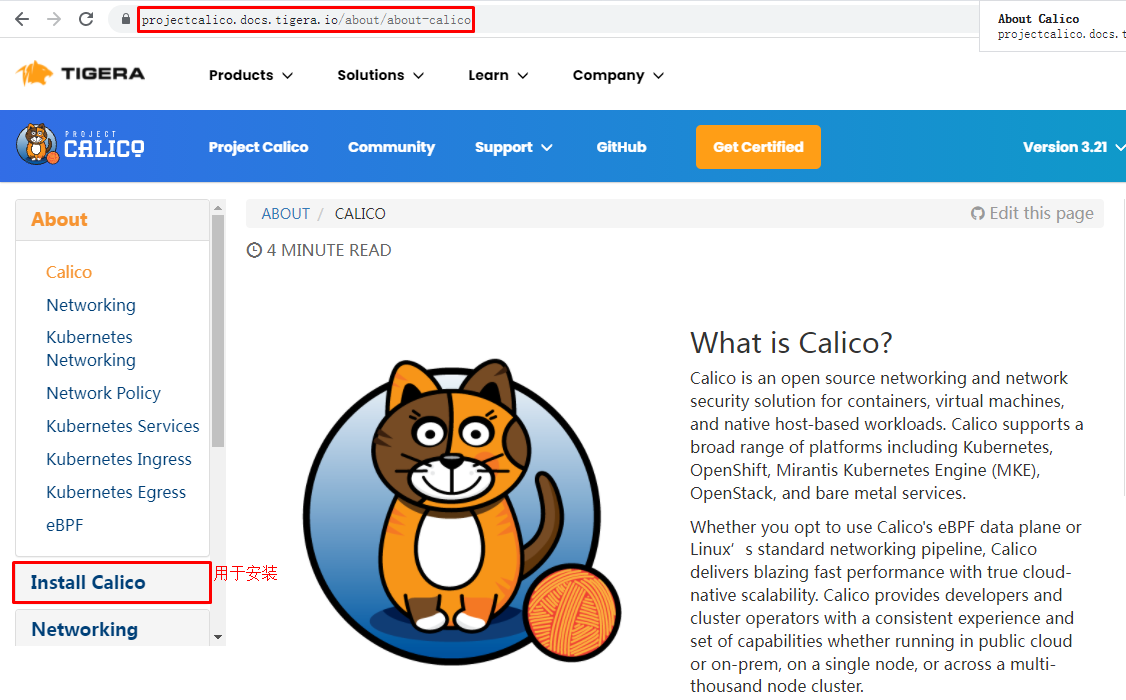
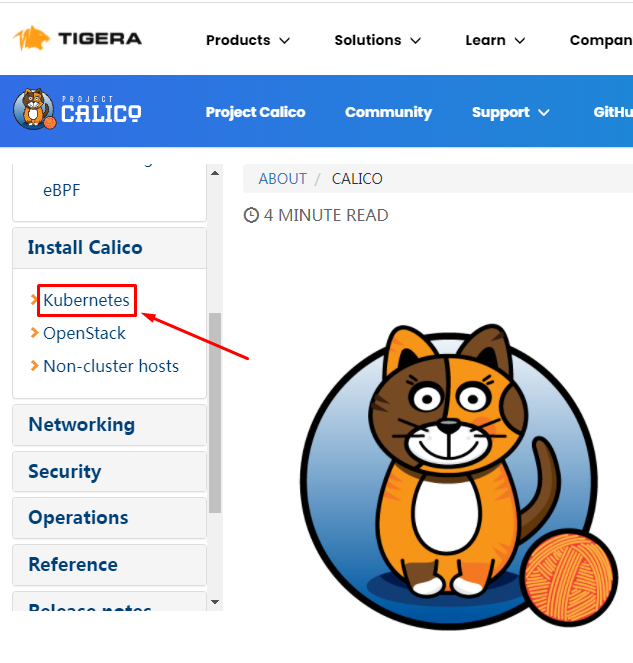
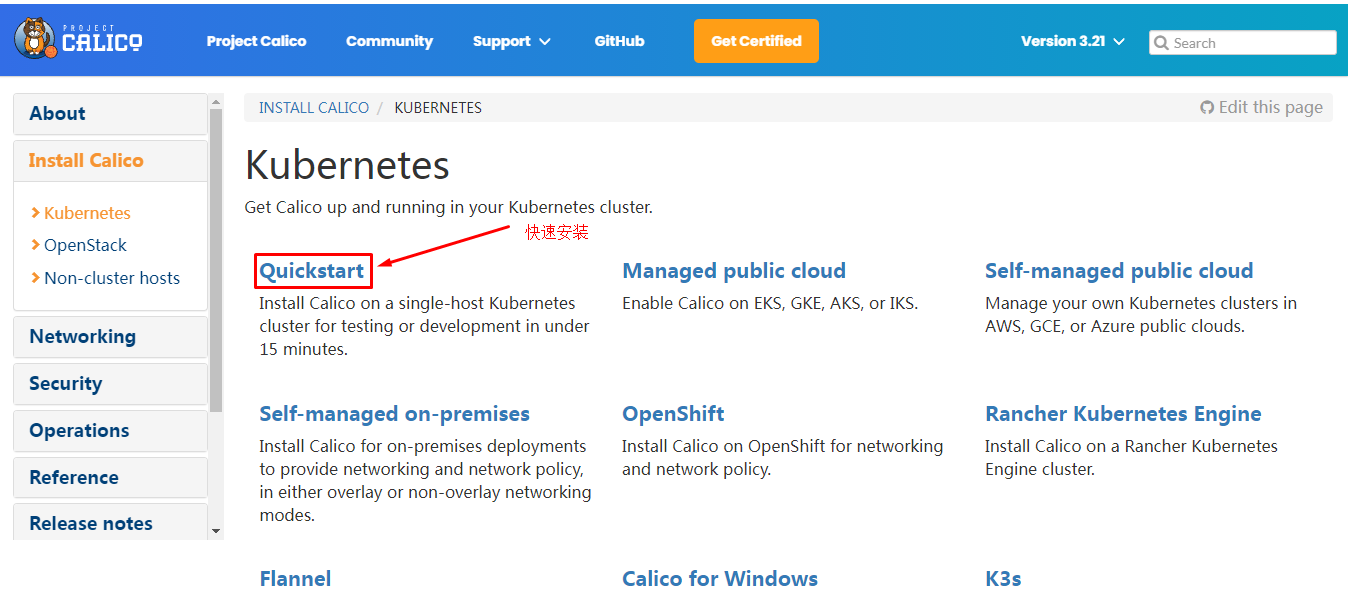
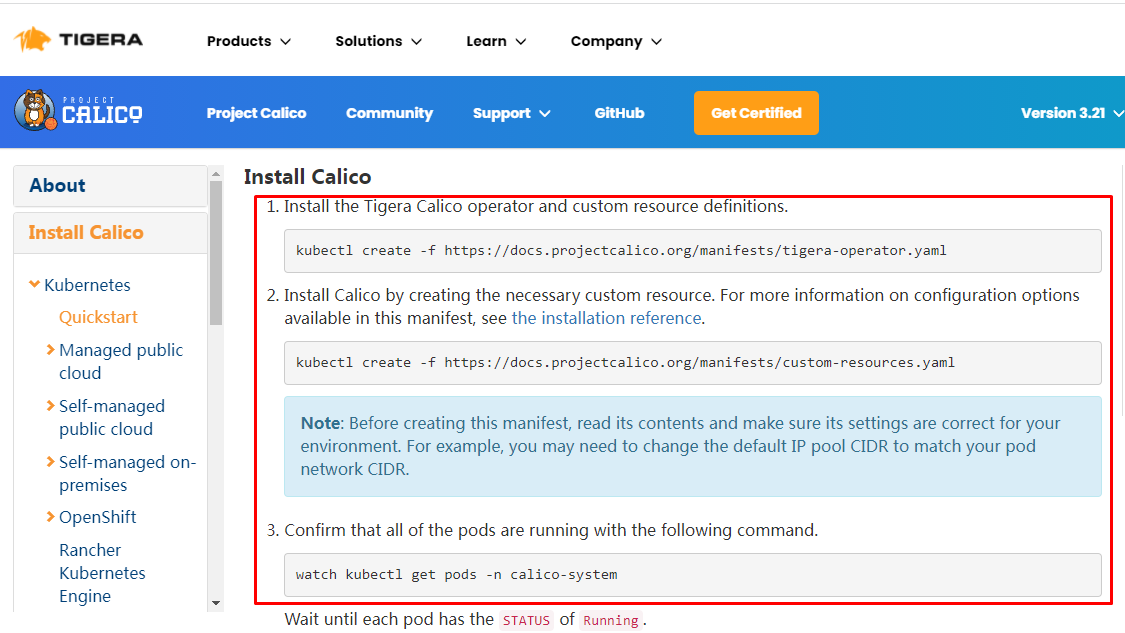
下载operator资源清单文件
# wget https://docs.projectcalico.org/manifests/tigera-operator.yaml
应用资源清单文件,创建operator
# kubectl apply -f tigera-operator.yaml
通过自定义资源方式安装
# wget https://docs.projectcalico.org/manifests/custom-resources.yaml
修改文件第13行,修改为使用kubeadm init ----pod-network-cidr对应的IP地址段
# vim custom-resources.yaml
......
11 ipPools:
12 - blockSize: 26
13 cidr: 10.244.0.0/16
14 encapsulation: VXLANCrossSubnet
......
应用资源清单文件
# kubectl apply -f custom-resources.yaml
监视calico-sysem命名空间中pod运行情况
# watch kubectl get pods -n calico-system
Wait until each pod has the
STATUSofRunning.
删除 master 上的 taint
# kubectl taint nodes --all node-role.kubernetes.io/master-
已经全部运行
# kubectl get pods -n calico-system
NAME READY STATUS RESTARTS AGE
calico-kube-controllers-666bb9949-dzp68 1/1 Running 0 11m
calico-node-jhcf4 1/1 Running 4 11m
calico-typha-68b96d8d9c-7qfq7 1/1 Running 2 11m
查看kube-system命名空间中coredns状态,处于Running状态表明联网成功。
# kubectl get pods -n kube-system
NAME READY STATUS RESTARTS AGE
coredns-558bd4d5db-4jbdv 1/1 Running 0 113m
coredns-558bd4d5db-pw5x5 1/1 Running 0 113m
etcd-master01 1/1 Running 0 113m
kube-apiserver-master01 1/1 Running 0 113m
kube-controller-manager-master01 1/1 Running 4 113m
kube-proxy-kbx4z 1/1 Running 0 113m
kube-scheduler-master01 1/1 Running 3 113m
4.8.2 calico客户端安装¶
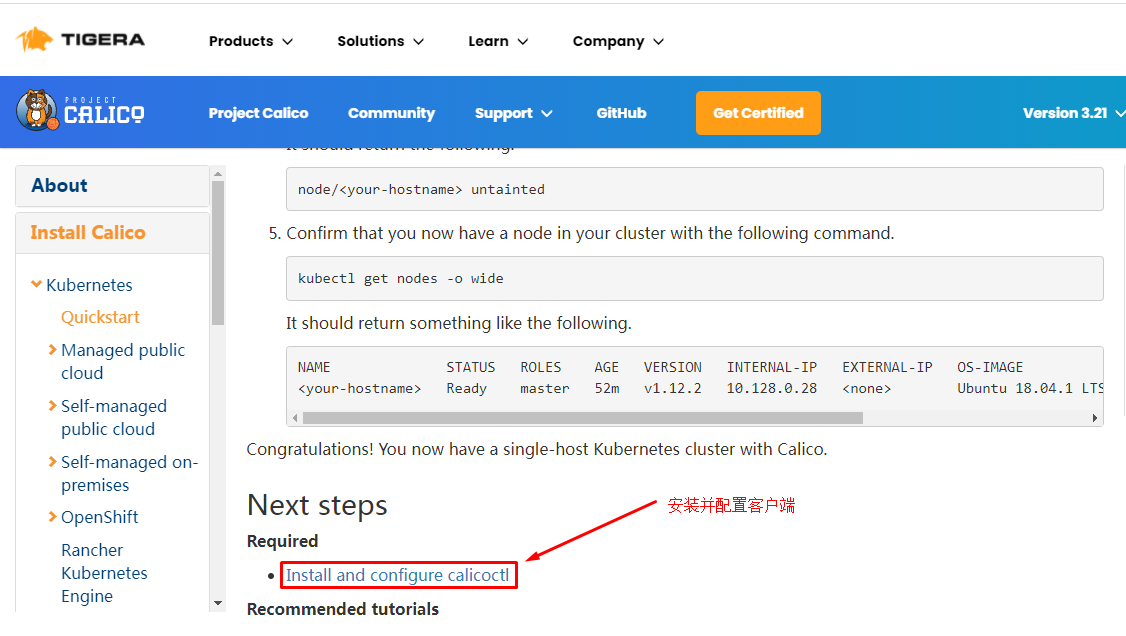
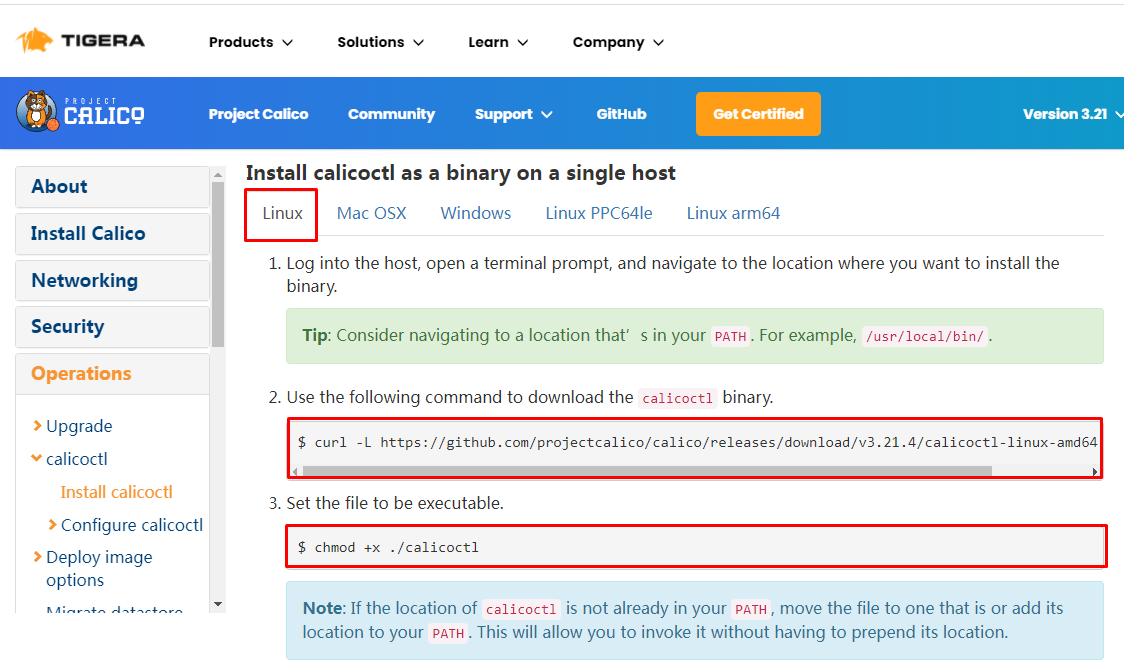
下载二进制文件
# curl -L https://github.com/projectcalico/calico/releases/download/v3.21.4/calicoctl-linux-amd64 -o calicoctl
安装calicoctl
# mv calicoctl /usr/bin/
为calicoctl添加可执行权限
# chmod +x /usr/bin/calicoctl
查看添加权限后文件
# ls /usr/bin/calicoctl
/usr/bin/calicoctl
查看calicoctl版本
# calicoctl version
Client Version: v3.21.4
Git commit: 220d04c94
Cluster Version: v3.21.4
Cluster Type: typha,kdd,k8s,operator,bgp,kubeadm
通过~/.kube/config连接kubernetes集群,查看已运行节点
# DATASTORE_TYPE=kubernetes KUBECONFIG=~/.kube/config calicoctl get nodes
NAME
master01
4.9 集群工作节点添加¶
因容器镜像下载较慢,可能会导致报错,主要错误为没有准备好cni(集群网络插件),如有网络,请耐心等待即可。
[root@worker01 ]# kubeadm join 192.168.10.11:6443 --token 9kz5id.pp5rhvzahj51lb5q \
--discovery-token-ca-cert-hash sha256:86f9c4471b6ef08090ecffadc798040fe5d8ef5975afe527e65d2f0aedf66493
[root@worker02 ~]# kubeadm join 192.168.10.11:6443 --token 9kz5id.pp5rhvzahj51lb5q \
--discovery-token-ca-cert-hash sha256:86f9c4471b6ef08090ecffadc798040fe5d8ef5975afe527e65d2f0aedf66493
在master节点上操作,查看网络节点是否添加
# DATASTORE_TYPE=kubernetes KUBECONFIG=~/.kube/config calicoctl get nodes
NAME
master01
worker01
worker02
4.10 验证集群可用性¶
查看所有的节点
[root@master01 ~]# kubectl get nodes
NAME STATUS ROLES AGE VERSION
master01 Ready control-plane,master 169m v1.21.0
worker01 Ready <none> 28m v1.21.0
worker02 Ready <none> 28m v1.21.0
查看集群健康情况,理想状态
[root@master01 ~]# kubectl get cs
NAME STATUS MESSAGE ERROR
controller-manager Healthy ok
scheduler Healthy ok
etcd-0 Healthy {"health":"true"}
真实情况
# kubectl get cs
Warning: v1 ComponentStatus is deprecated in v1.19+
NAME STATUS MESSAGE ERROR
scheduler Unhealthy Get "http://127.0.0.1:10251/healthz": dial tcp 127.0.0.1:10251: connect: connection refused
controller-manager Unhealthy Get "http://127.0.0.1:10252/healthz": dial tcp 127.0.0.1:10252: connect: connection refused
etcd-0 Healthy {"health":"true"}
查看kubernetes集群pod运行情况
[root@master01 ~]# kubectl get pods -n kube-system
NAME READY STATUS RESTARTS AGE
coredns-558bd4d5db-4jbdv 1/1 Running 1 169m
coredns-558bd4d5db-pw5x5 1/1 Running 1 169m
etcd-master01 1/1 Running 1 170m
kube-apiserver-master01 1/1 Running 1 170m
kube-controller-manager-master01 1/1 Running 14 170m
kube-proxy-kbx4z 1/1 Running 1 169m
kube-proxy-rgtr8 1/1 Running 0 29m
kube-proxy-sq9xv 1/1 Running 0 29m
kube-scheduler-master01 1/1 Running 11 170m
再次查看calico-system命名空间中pod运行情况。
[root@master01 ~]# kubectl get pods -n calico-system
NAME READY STATUS RESTARTS AGE
calico-kube-controllers-666bb9949-dzp68 1/1 Running 3 70m
calico-node-jhcf4 1/1 Running 15 70m
calico-node-jxq9p 1/1 Running 0 30m
calico-node-kf78q 1/1 Running 0 30m
calico-typha-68b96d8d9c-7qfq7 1/1 Running 13 70m
calico-typha-68b96d8d9c-wz2zj 1/1 Running 0 20m